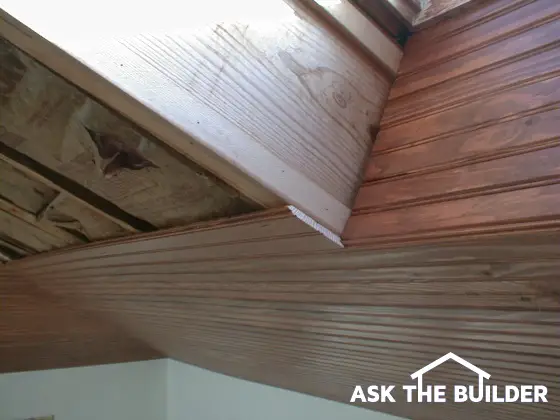Vaulted Wood Ceilings

Install T&G wood on a vaulted ceiling requires special talent, tools and techniques. You will probably discover that some colored wood putty will also come in handy.
Vaulted Wood Ceilings
DEAR TIM: While paging through a home decorating magazine I saw a vaulted ceiling that was covered with wood. The look was stunning. I have a corner room of my home that has two drywall vaulted ceilings that rise from each wall producing a diagonal seam in the ceiling. How difficult is it to install wood on this surface? What tools do I need and what can be done to make the job go as smooth as silk? Barb F. San Diego, CA
DEAR BARB: Stunning you say? My wife and other customers have also been heard to exclaim: sensational, awe-inspiring and dazzling. Based upon your description, it sounds as if your ceiling is nearly identical to one in my own bird room. We call our sun room the bird room because that is where our singing male canary lives. The Douglas Fir bead board ceiling in my bird room gets compliments from every person who walks into the room. For some reason our guests' attention seems to be drawn to the wood ceiling. Perhaps the two skylights that drown the room with light are partially responsible.
Is installing wood on a vaulted ceiling hard to do?
Unfortunately, you have selected perhaps the toughest ceiling to tackle. I would have much preferred it if you had told me the ceiling was flat or a standard one-plane vaulted ceiling. The intersecting ceiling planes of a hip roof add a significant degree of difficulty to the project. Installing wood around skylights adds yet another level of complexity. Be thankful you don't have those to contend with.
Here is a list of tools you will need to complete this job:
- a miter box saw
- a chalk line
- hammer and nail sets or a nail gun(preferred)
- a circular saw or table saw(preferred)
- ladders and/or scaffolding(preferred)
- sandpaper and brushes
How do you find the center-line of the ceiling joists / roof rafters?
The first task you need to complete is locating the center line of the ceiling joists/roof rafters. You can do this the old-fashioned way using a nail and hammer or with a modern stud-finding tool that peers through the drywall and locates the solid wood for you. Use the chalk line to snap a line down the center of the rafters from the intersecting hip to where the rafter passes over the exterior wall. Be sure to check for solid wood along both sides of the giant diagonal seam that extends from the outside corner to the peak of the roof. You need solid wood on either side of this seam to secure the ends of the wood pieces that fall between rafters.
What is the best method to use for installation?
Don't even think of installing one piece of wood until you have pre-stained and urethaned every piece of wood you will need for the job. Trying to apply these liquids upside down after unfinished wood is installed is a nightmare. Wood ceilings look best when you use tongue and groove lumber that interlocks. This method allows for blind nailing so you do not see any nails after the ceiling is installed.
It is extremely important to make sure the actual tongue is covered with stain and urethane. Seasonal movements in the wood can partially expose the tongue. If you fail to stain it, you may have unwanted racing stripes on your gorgeous wood ceiling at some future date.
The nails are installed through the tongues. Drive them at a 45 degree angle in the corner where the base of the tongue meets the actual body of the board. The nails must be long enough to penetrate one to one and one quarter inches into the solid wood rafters that are currently hidden by the existing drywall ceiling.
CLICK or TAP HERE to get FREE quotes from local companies that will install wood on your ceiling.
You will need a circular or table saw to make an angle cut on the groove side of your first starter piece. The angle will reflect the actual pitch of the vaulted ceiling. Failure to make this cut produces an unsightly gap where the wood strip meets the wall. You will also have to face nail this first starter piece so the bottom does not fall away from the ceiling. All other pieces of wood will be blind nailed through the tongues.
How Do You Get the Pieces of T&G Lumber Tight?
Tongue and groove lumber does not always interlock with ease. Never tap or hammer the tongue end to try to drive the board into place. You can flatten and damage the tongue making it impossible to interlock the next piece of lumber. A better method is to use a small one-foot long piece of scrap wood. The groove of this smaller piece should easily fit on the troublesome board. You can then hit the scrap piece of wood which in turn pushes the larger piece into place.
How do you hide the imperfections or small nicks?
Colored wood putty that matches the finished wood is great for filling imperfections, nicks, or small knots. Keep the stain on hand as well to touch up scrapes that will happen as you handle the finished wood. Use a small brush or a cotton swab to apply the stain and/or urethane.
Column 493
5 Responses to Vaulted Wood Ceilings